Hornwort aquarium plant: description, planting and content
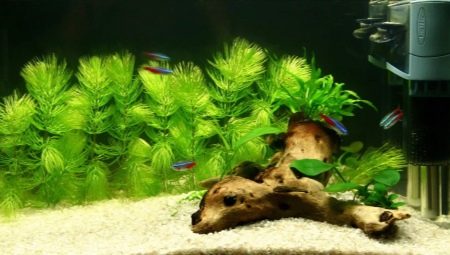
Hornwort (Ceratophýllum) is considered the most abundant aquatic plant in the world. It is very unpretentious, undemanding to lighting and water temperature, and is inexpensive. Almost all novice aquarists begin to "settle" their first aquarium with the purchase of this particular hydrophyte, which accelerates the adjustment of the biological balance in the new aquarium.
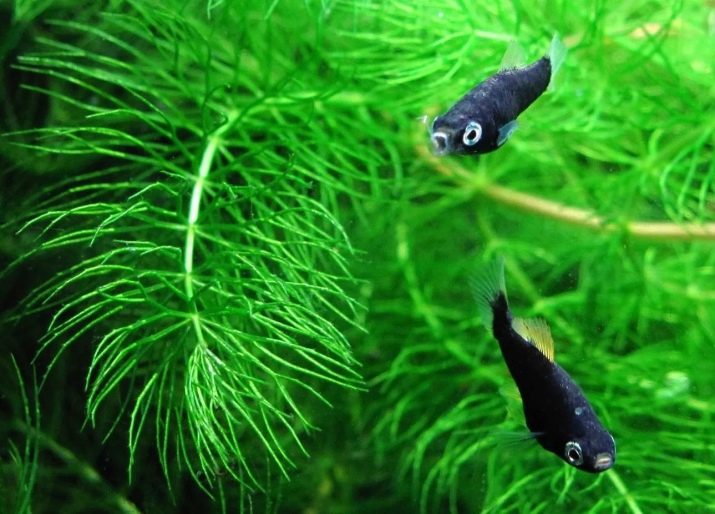
Peculiarities
Hornwort is a perennial aquatic plant. Found on all continents except Antarctica. In cultural cultivation, it is used for landscaping aquariums and home ponds. Attractive appearance combined with beneficial properties ensure the constant demand for ceratophyllum. Hornwort is versatile. This is both a decorative element in the design of an aquarium, and a spawning phyto-substrate, and a biological filter that actively purifies water from nitrates and organic matter.
Stems are thin, twisting, bushy, covered with acicular green or brown-green leaves, similar to coniferous needles. The dissected leaves resemble horns, surrounding the stem in the form of a fluffy decorative bunch. Hornwort is freely located in the water column, can partially protrude above the surface, and does not have a root system. Nutrition comes directly from the water to the cells of the leaves and stems. The filamentous stem processes of the rhizoid are attached at the bottom of the aquarium to soil elements - driftwood, stones, silt.

Flowering occurs in the water column. Loose panicle inflorescences with small (about 2 mm) unisexual flowers on a short peduncle are fixed in internodes.Pollinated under water by streams of water. The hornwort fruit is a small nutlet (up to 5 mm) with thorn-like growths.
A characteristic feature of this type of aquatic flora is the enveloping of foliage with a cuticle - a thin fat-like shell of cutin substance. The cuticle acts as a kind of membrane between the leaves and the aquatic environment in the aquarium, protects the hydrophyte from being eaten by the inhabitants of the aquarium.
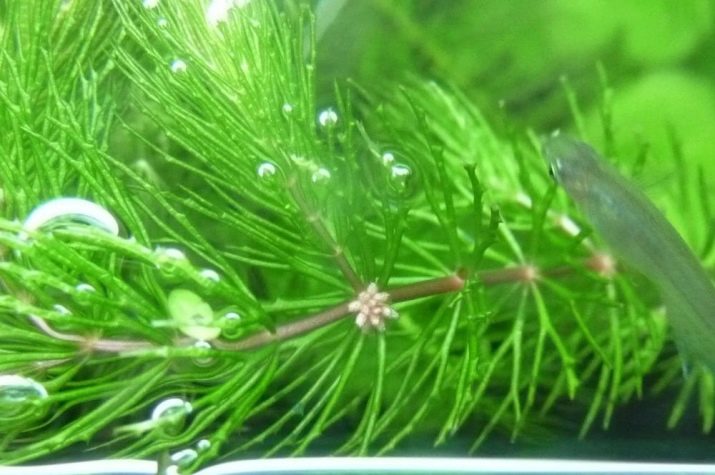
Varieties
There are about 30 botanical species of hornwort, but several are used in the aquarium hobby.
- Submerged (aka dark green, underwater, three-boned). It has thin long reddish stems and dark green needle-like dissected leaves. Grows in the water column. Can be grown free-floating or attached to the ground. In the conditions of the aquarium, the seasonality of growth of this species of hornwort is preserved. With a decrease in temperature in winter, growth slows down, the plant sheds part of the lower leaves (only the tops of the shoots remain) and "fits" to the bottom for wintering.
Received universal recognition and widespread among aquarists around the planet for its versatility, unpretentiousness, rapid growth.

- Semi-submerged (light green) hornwort has light green dissected leaves and a branching brittle stem. It is growing rapidly. In low aquariums, it can shade other green flora and therefore requires constant growth control. Intense light affects the color of the plant - delicate light green leaves take on a scarlet hue. In pet stores in the departments of water floristry, it is rarely sold due to the fragility of the stems.
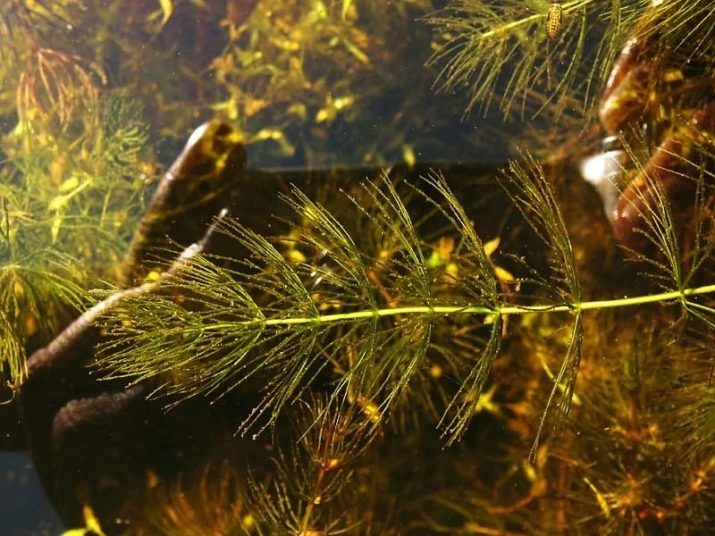
- Mexican. Grows well in soft and hard water. It survives in cold (up to 6 degrees) water, it develops well in tropical aquariums with a temperature of + 25 ... +30 degrees. Placed along the side or near the back of the aquarium. Decorative compact thickets of Mexican hornwort from 15-20 stems look picturesque.
The disadvantage of this species is the extreme fragility of the stems, which creates significant problems during its transportation and prevents its widespread introduction into aquaculture.
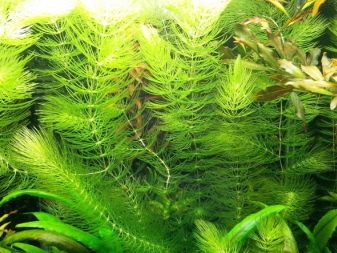
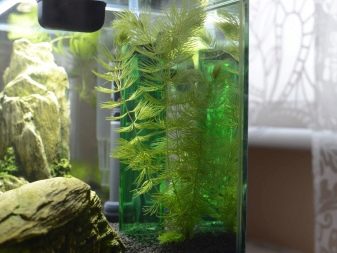
- Cuban (red-stemmed, "fox tail"). It has a highly branching stem of a purple hue. The internodes are located close to each other, the foliage is fluffy, abundant. The bushy branches are extremely beautiful, in shape they are similar to a thick fox's tail, so this name stuck with the Cuban hornwort. The peculiarity of this variety is constant year-round growth without any additional tweaks.
It has the highest decorative effect and the most durable stem of all types.
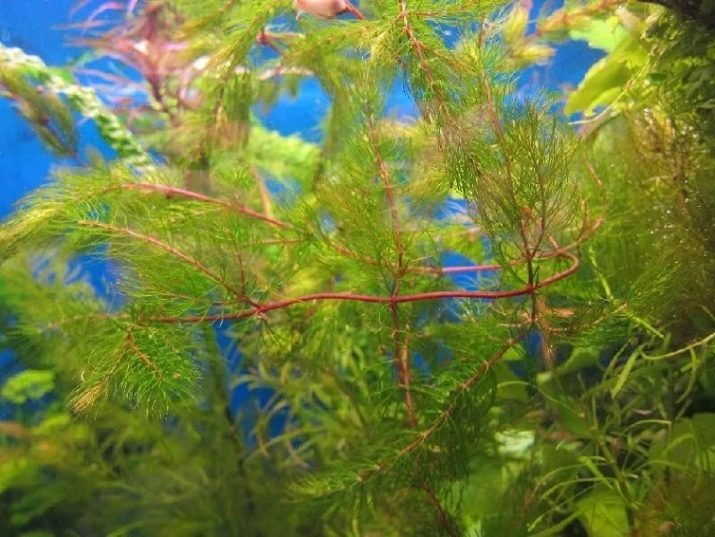
Growing conditions
Hornworts are undemanding to the conditions of detention. This hydrophyte feels most comfortable in water at a temperature of + 22-25 degrees, with an average water hardness and in a neutral or slightly acidic environment (pH 5.5-6.8). It should be noted that Warm water promotes the rapid growth of ceratophyllums.
The illumination mode is important for hornworts. Daylight hours should last 10-12 hours. Hornwort prefers weak, diffused light. When placing an aquarium, it is imperative to take into account that ceratophyllums cannot stand direct sunlight; under their prolonged exposure, plants die.
The size of the aquarium should be chosen taking into account the rapid growth of ceratophyllum. These plants are capable of filling an entire small aquarium in a short time. The optimal capacity is 100-120 liters, but you can grow them in small tanks if you constantly monitor the growth of plants and cut them in time.
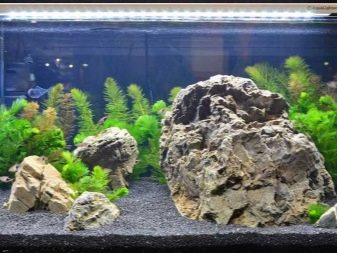
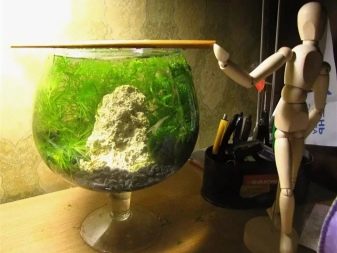
Reproduction
Breeding ceratophyllum in an aquarium is considered an easy process. New shoots grow at the hornwort from the tops of the stems. It is enough to carefully cut off the young shoot, lower it into the aquarium and leave it to float freely near the adult plant. Sometimes the shoots separate themselves from the mother plant, then the new hornwort begins to grow on its own. You can propagate the bush vegetatively - divide the long stem into parts (about 10-15 cm each).
Cuttings attached to the ground or freely floating in the water soon begin active growth. The grown stem begins to bush with new fluffy shoots. Amazing openwork wood fills more and more space in the aquarium.
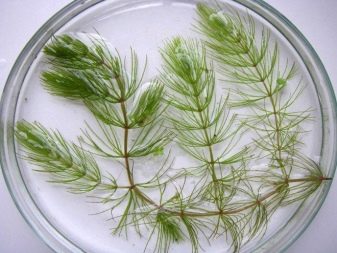
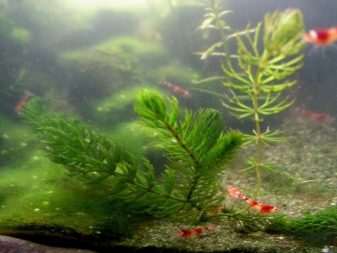
How to plant?
Most aquarists do not plant hornworts, but leave new plants floating freely in the pond. But a free-floating plant often grows into a complex nodal formation that cannot be unraveled by any means. Recommended for planting special suction cups. The planting material is neatly attached to them with a fishing line, and the suction cups are fixed to the bottom or walls of the aquarium. This method greatly facilitates subsequent care: it is convenient to remove the plants from the container for washing and removing rotten areas.
It is not necessary to add nutritious dressings to the bottom substrate, since hornworts have no roots and they completely feed from the aquatic environment.
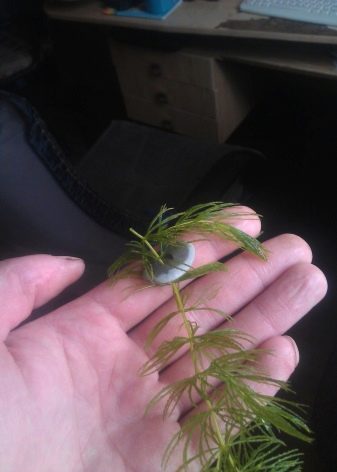

Correct care
It must be understood that hydrophytes are an important link in the biological balance of an aquarium. Aquatic plants need proper maintenance, constant attention and proper care. Under favorable conditions, ceratophyllum grows very quickly (in a month the stem can increase by 0.9-1.2 m) and can fill the entire space in the aquarium, suppressing other vegetation.
In caring for a hornwort, 2 aspects are required.
- Systematic pruning overgrown stems so that the decorative integrity of the reservoir is not disturbed and other types of aquatic flora are not oppressed.
- Regular rinsing of foliage under running water, to cleanse it of debris, plaque and organic residues that accumulate on the plant, like on a biological filter. This should be done with the utmost care so that after the procedure as few fragments of branches from fragile stems as possible remain.
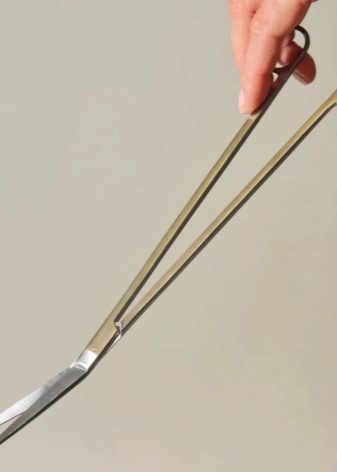
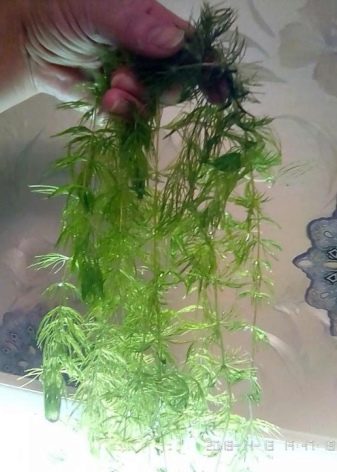
Novice aquarists (and not only them) should be clearly aware that unpretentious, unassuming hornwort is a living organism. The "Spartan" conditions of his detention should not be considered the norm.
The plant will not develop successfully without proper lighting, in an openly dirty reservoir, in an aquatic environment with critical hydrochemical indicators.
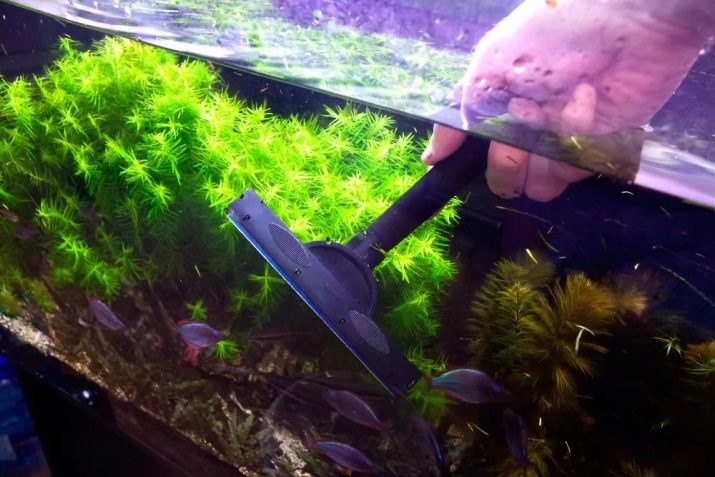
Possible problems
Hornworts are disease resistant and infrequently affected by disease. When exposed to direct sunlight or too aggressive lighting, the delicate leaves turn yellow. When such symptoms appear, it is necessary to eliminate the unfavorable factor and cut off the damaged parts of the plant.
A sharp change in environmental parameters (if it becomes necessary to transplant a bush to another aquarium) can lead to the loss of leaves, the bare stem will no longer be able to recover. You can cut off the apical shoots and put them in the water, but you will have to discard the stem.
If a plant infection has entered the aquarium, you need to carefully remove the hornwort and all the aquarium flora, rinse carefully under running water and treat with a special light disinfectant. Plants should be placed in a temporary tank to wait out the disinfection period of the aquarium.
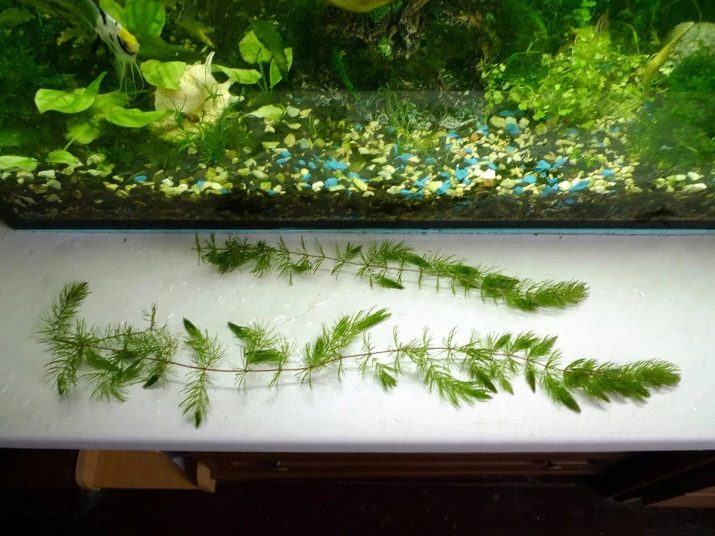
The selection of aquatic flora for an aquarium is not an easy task. Aquarists strive to fill the aquarium not only with highly decorative plants, but also with useful properties. In this regard, not every aquatic plant can be compared to the hornwort. It quickly adapts to a new aquarium and begins to work actively while other plants are in the acclimatization stage.
It actively absorbs carbon dioxide, produces oxygen, and normalizes the nitrogen cycle. Water in aquariums with hornwort stays clean for a long time, since this plant is a biological filter. Residues of organic matter, suspended matter, silt are deposited on its dense greenery. All this, with a sufficient amount of oxygen, is rapidly oxidized and the water does not become cloudy.
Fluffy greenery, in addition to its aesthetic function, is an ideal spawning substrate and habitat for fish fry.
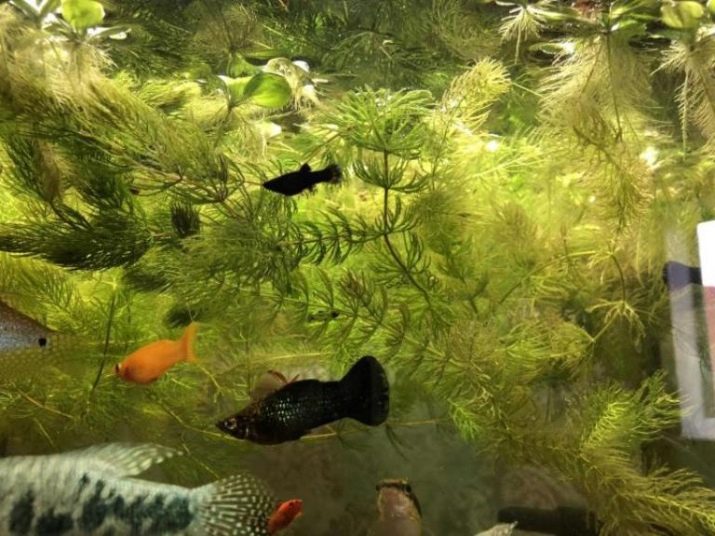
Among the disadvantages of the plant, there is a significant fragility of the stems, as well as the need to constantly monitor its growth in order to timely eliminate the excessive filling of the reservoir with greenery. Any aquarist, even a beginner, can handle the cultivation of hornwort.
Tips for caring for your hornwort await you next.








